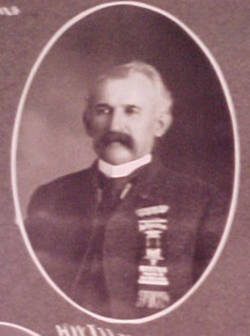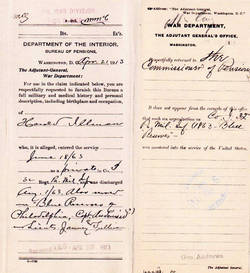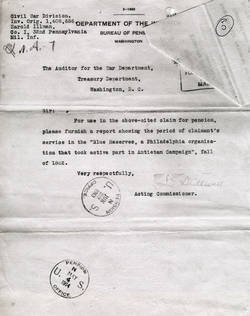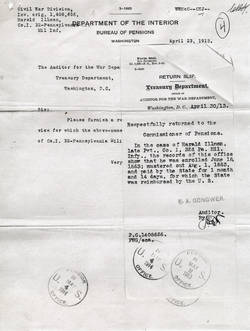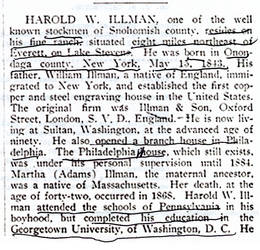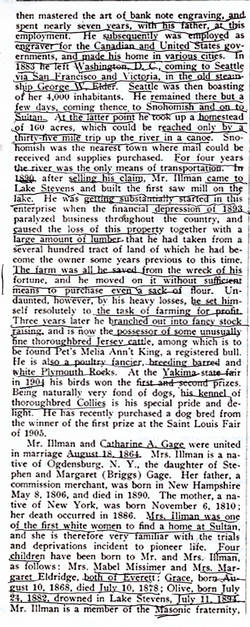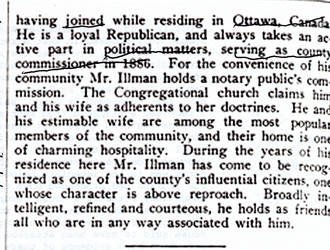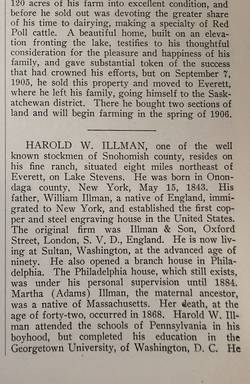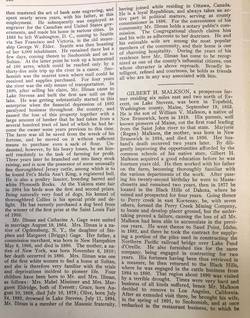Harold W. Illman
Representing: Union
Unit History
- 32nd Pennsylvania Infantry H
- 8th Pennsylvania Infantry C
Full Unit History
8th PENNSYLVANIA VOLUNTEER INFANTRY
Organized: 9/12/62
Mustered In: 9/12/62
Mustered Out: 9/25/62 Harrisburg, PA
32nd PENNSYLVANIA INFANTRY
Organized: 6/18/83
Mustered In: 6/16/63 Harrisburg, PA
Mustered Out: 8/1/63 Philadelphia, PA
Regimental History
REGIMENTAL HISTORY: (8th)
In August, 1862, having bested troops under Union Gen. John Pope at the battle of 2nd Bull Run/Manassas Confederate Gen. Robert E. Lee's Army Of Northern Virginia moved northward into Maryland. This caused alarm in the State of Pennsylvania and resulted in Governor Curtin's call for all able bodied men to enroll in militia units in defense of the state. Everywhere men flew to arms and units of Pennsylvania emergency troops such as the 8th moved promptly to the state capital at Harrisburg and other locales to stand in readiness in case they were needed to confront the Rebel menace. Fortunately for Pennsylvania, the Confederates were defeated at South Mountain 9/14/1862 and Antietam 9/17/1862, Maryland and moved back southward into Virginia. The danger of an invasion of Pennsylvania having passed - at least for the time being - the militia units were disbanded with the men returning to their homes.
REGIMENTAL HISTORY: (32nd)
During the month of June, 1863 Confed. Gen. R.E. Lee's army was again crossing the Potomac River and moving northward, this time into Pennsylvania. Once again, the Governor sent out a call for the formation of emergency militia units that would serve for 90 days or until the crisis passed. The 32nd was one such regiment. Organized on 6/18 the 32nd marched to the state capital at Harrisburg where, on 6/26 it was mustered into Federal service. Soon after the Union's Army Of The Potomac's defeat of the Rebels at Gettysburg, PA (July 1st, 2nd, & 3rd), the emergency regiments were mustered out of existence.
Soldier History
SOLDIER: (8th)
Residence: Philadelphia, PA Age: 20.4 mos.
Enlisted/Enrolled: 9/11/62 Philadelphia, PA Rank: Pvt.
Mustered In: Inf. Not Avail.
Mustered Out: 9/24/62
Highest Rank: Pvt.
SOLDIER: (32nd)
Residence: Philadelphia, PA Age: 21.1 yrs.
Enlisted/Enrolled: 6/16/63 Philadelphia, PA Rank: Pvt.
Mustered In: 6/26/63 Harrisburg, PA
Mustered Out: 8/1/63 Philadelphia, PA
Highest Rank: Pvt.
Family History
PERSONAL/FAMILY HISTORY:
While birth years for Harold W. (although it is not documented the W likely stands for William) Illman vary widely, according to two sources, he was born in 1843. Herein, we too, will adopt 1843. The month and date of birth was May 15th.
Harold was born in or near the community of Little Falls in Herkimer County, New York. His parents were William W. (b. 1817 England) and Martha (nee Adams b. 1823 NY or MA) Illman. He was, apparently, the eldest of five known Illman children. His younger siblings were Emmel (Emily) (b. 1846 PA), Walter (b. 1850 PA), Agnes (b. 1852 PA) and Grace (b. 1853 PA).
By the time of the 1850 U.S. census the Illman’s were no longer in Little Falls, but in Moyamensing Township outside of the city of Philadelphia, Pennsylvania. Ten years later, the 1860 population tally also placed the Illman's in the Philadelphia area. There, family patriarch who, when in New York had established the first copper and steel bank note plates engraving business in the United States, had established his second, well respected print shop called The Philadelphia House. Harold, then, was not a farm boy but a city - oriented lad who was likely educated in the urban Pennsylvania school system and, at some point, worked with his father for seven years learning the art of printing and crafting metal engraving plates.
On 9/11/62 twenty year old Harold - under the name Harry - responded to his state's governor's call to arms and enlisted in the 8th Pennsylvania Infantry, an emergency militia regiment also known as the "Blue Reserves." The unit was raised in response to Confederate forces evading nearby Maryland. Also, enrolling in the 8th were two other Illman’s, likely Harry's cousins. The Illmans' military experience lasted a grand total of thirteen days.
Nine months later, on June 18, 1963 Harold and his cousins again responded to a call to defend their state as Confederate forces moved toward the small Pennsylvania town of Gettysburg. On this occasion their period of service was approximately 45 days. As far as is known, for Harold this period of service, as that in 1962, did not involve being exposed to enemy gunfire.
The next event of significance in Harold's life came the following year when, on an undocumented date in 1864, he wed to Annette "Nettie" Catherine/Catherine Annette "Nettie" Gage (b. 1847 NY). The Union would last until Harold's death in 1928 and produce four daughters: Mabel (b. 1865 PA), Margaret "Madge" (no b.d. PA), Grace (b. 8/10/68 PA) and Olive "Ollie" (b.7/24/82 Canada).
Harold and family cannot be found in the 1870 U.S. Census, but from all available evidence, during that year he was likely attending school at Georgetown College near Washington, D.C. He would emerge from that institution of higher learning in 1873, reportedly with a degree in law. However, instead of pursuing a career as an attorney he obtained a position as a metal plate engraver with the U.S. Government’s Department Of The Treasury.
In 1878 tragedy struck the Illman family when daughter Grace died. The cause of her death is not documented. Also not known is where the death occurred, but likely it was in the Washington, D.C. area.
The Census of 1880 found the Illman’s or at least Harold - a roomer - in Washington, D.C. Two years later, on 7/24/82, when daughter Olive was born the family was in the city of Ottawa, Quebec, Canada. They had been drawn to that locale after Harold accepted a plate engraving position with the Canadian Government.
In 1883 Harold and family departed Canada and travelled back to the Puget Sound region of Washington Territory. Their means of transportation was the steamship George W. Elder. Their route of travel was around the southern tip of South America, northward to San Francisco, California and then on to Victoria, British Columbia, Canada. From there the ship steamed southward to Seattle, King County, Washington Territory where the Illman family disembarked. They remained in Seattle but a few days before moving northeastward to the inland Snohomish County community of Sultan. What had drawn them to this wilderness area near the Cascade Mountain Range is not known, but local history points to Annette Illman as being one of the first white women in that area.
An 1885 Snohomish County census placed Harold, Nettie as well as daughters Madge and Olive in a household seemingly headed by a 22 year old teacher identified only as Helen. Interestingly, also under Helen's roof was 66 year old Harold (W.) Illman - Harold's now farmer father - and his 30 year old sister, Grace. Had the elder Illman and Grace come to the Washington wilderness with Harold's family or had they preceded them there and convinced Harold and family to join them? We will likely never know. As a footnote to this household, also therein was a 25 year old male identified only as William.
Despite the remote nature of the Sultan community, Harold's trek into the forests of the region was not yet over. In 1886 he applied for, and was granted, a 160 acre homestead located along the Skykomish River. While Sultan itself was a fairly remote community, the location of the homestead was even more so as, for four years, the only access to the site was a thirty five mile canoe trip up the river. Picking up mail and supplies required a 70 mile round trip - via river - to Sultan.
Above and beyond the remoteness of his new home, Harold proved to be active in Snohomish County politics. In '86, the same year he established his homestead, he was elected to a term as a county commissioner. The trip to and from the Snohomish County seat located in Everett must have been a real challenge.
In 1890 Harold reportedly sold his Skykomish River homestead. He, Nettie and Olive then moved westwardly and settled on Snohomish County's Lake Stevens. There, Harold established the first saw mill on that lake.
The Lake Stevens years at first proved to be successful, but then things soured. In 1893 the depression that was sweeping the U.S. caused Harold to lose not only his sawmill, but several hundred acres of timber he had acquired earlier. He was, however, able to save his Lake Stevens farm, but found the family living there "without funds to even purchase a bag of flour." 1894 likely proved even more devastating for the Illmans as, on July 11th of that year, daughter Olive drowned in the lake.
Despite his financial setback and family tragedy, the "resilute" Harold plunged ahead in life. In 1896 he used his farm to begin branching out into fancy stock breeding. His first animals were thoroughbred Jersey cows. Barred and Plymouth Rock poultry and a kennel of thoroughbred collies followed. By 1904 his poultry was garnering 1st and 2nd place prizes at eastern Washington's Yakima County fair. In 1905 he purchased a first prize winning dog breed from that year's St. Louis, MO World's Fair. Whether or not it can be believed as true, the Everett City Directory for that same year noted that the stock breeder was a resident of that city.
Dropping back, the census of 1900 found Harold and Annette on their farm which was explained to be in the Highland voting District of Snohomish County, some eight miles northeast of Everett on Lake Stevens. A decade later, the census of 1910 placed him and Annette still in Snohomish County, and likely on their farm, but now that area was characterized as the Hartford voting district. Interestingly enough, by that late date Harold was, finally, listing his occupation as "lawyer." [Note: According to one source the location of the Illman’s Lake Stevens farm was described as being located near Rucker’s – formerly Illman’s ? - Mill and later became the Kansas Campground.
In 1913 Harold began the paperwork process to obtain a U.S. Government disability pension. What he quickly found was that while he had served his state and Uncle Sam twice during the Rebellion, his days of service fell far short of the 90 days necessary to qualify for a pension stipend. Claim rejected.
1914. Harold and Annette sold their Lake Stevens home and moved to a Grand Army Of The Republic community located in Florida. It was there, in St. Cloud, Osceola County, the census takers for 1920 found the couple. By this time Harold noted that he had "no income."
Six years later, in 1926, Harold and Annette returned to Washington. On their return they did not resettle in Snohomish County, but built a home along the shores of Lake Washington in Seattle. It was in that home on 5/12/28, that the 85 year old former civil War soldier died. According to the Granite Falls (Snohomish County) Record newspaper, his cremated remains were then buried - not in Seattle, but - in Sultan, beside his father.
The U.S census for 1930 found the widowed Annette in the eastern Washington Benton County community of Prosser. There, she was living in the home of her married daughter Mabel Missimer. Annette died on 12/14/35. Her final resting place is not known.
Cemetery
Buried at Sultan Community Cemetery

